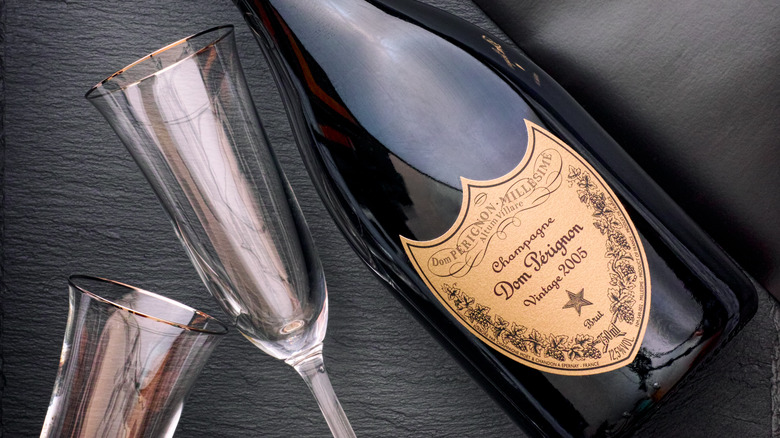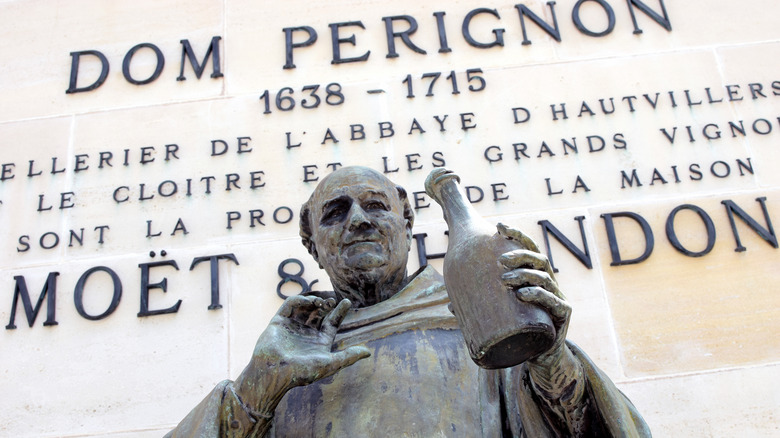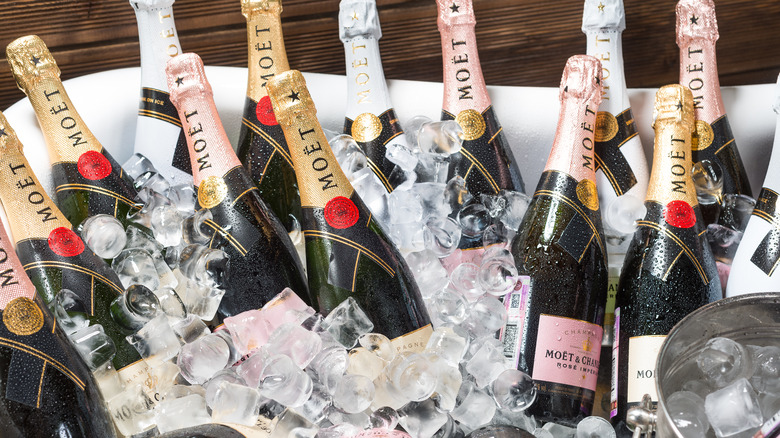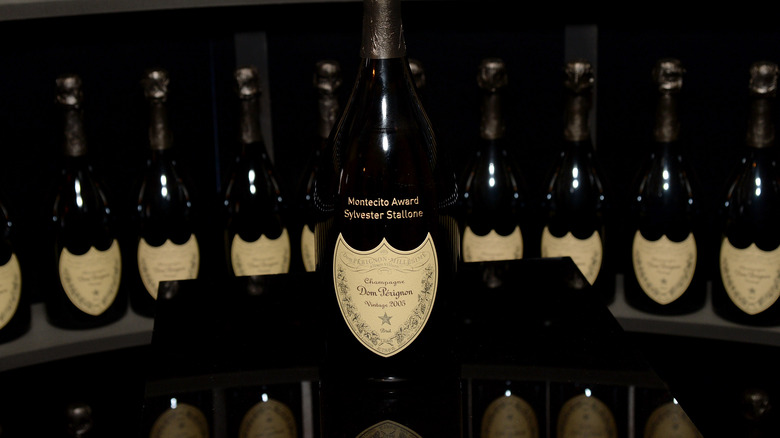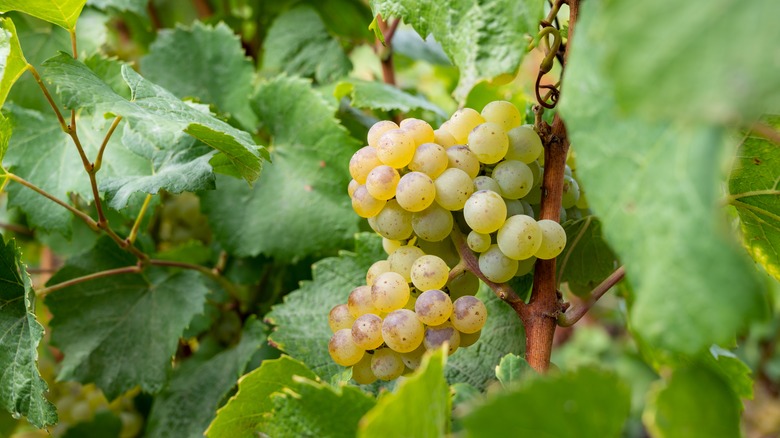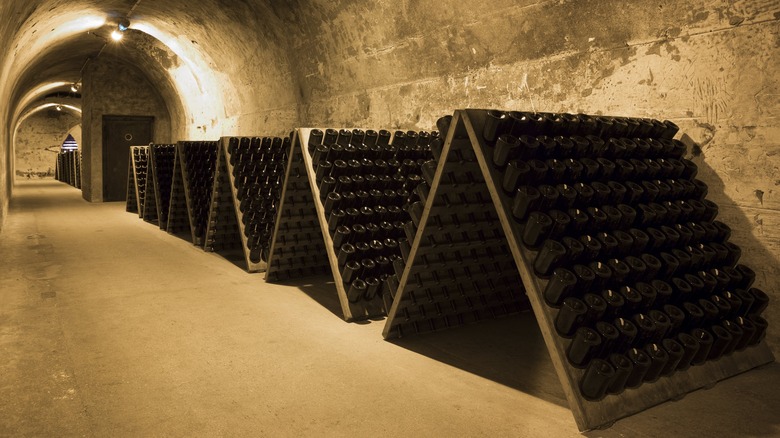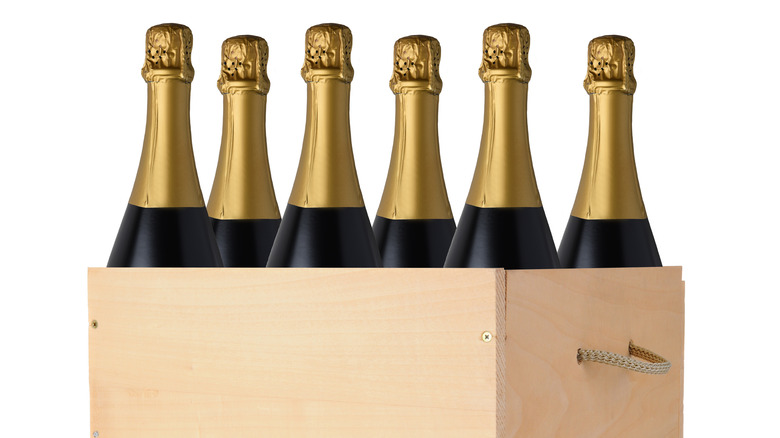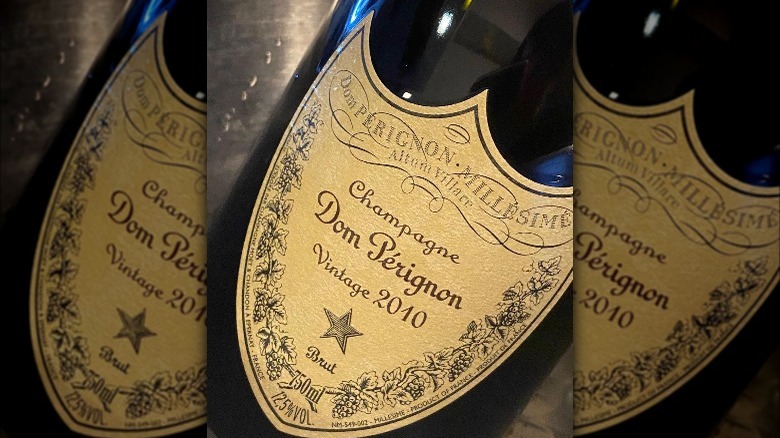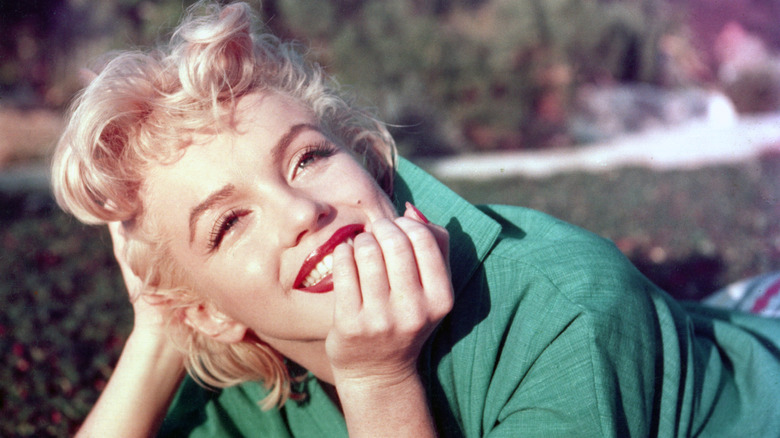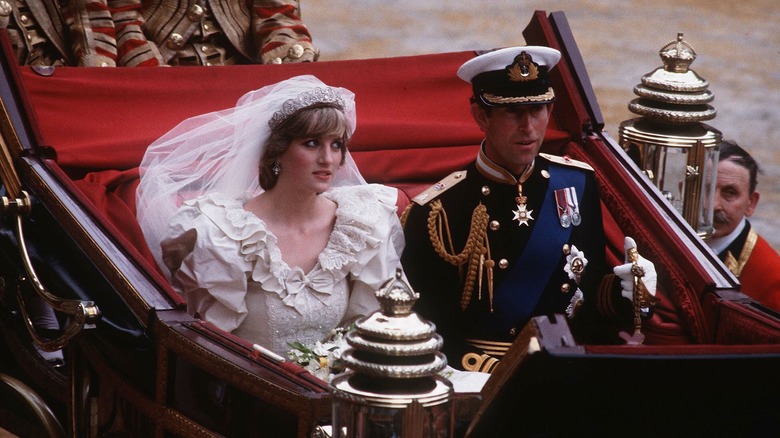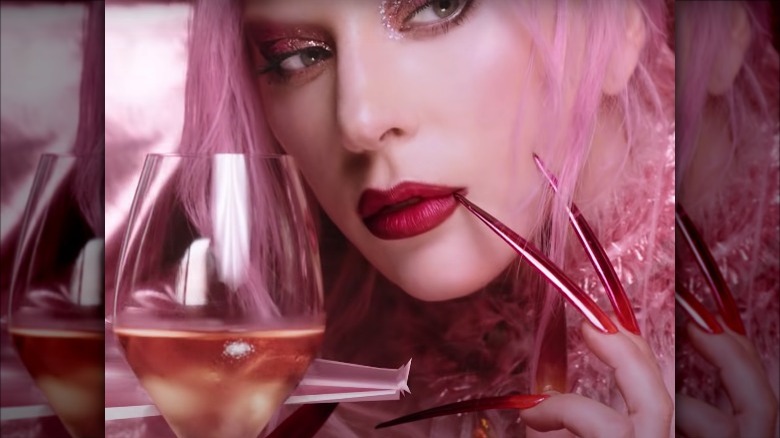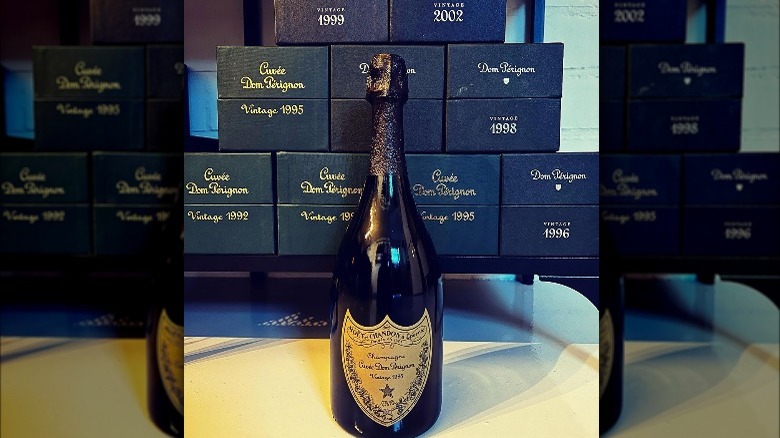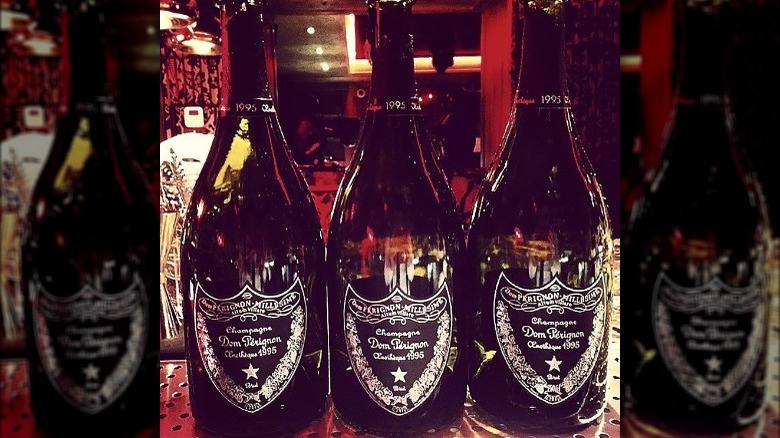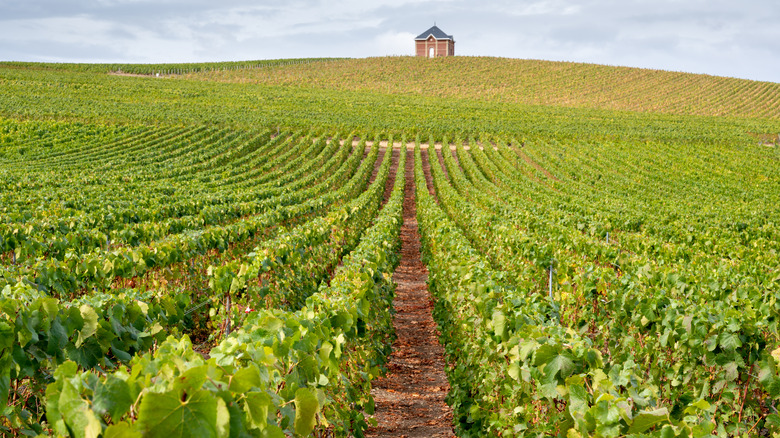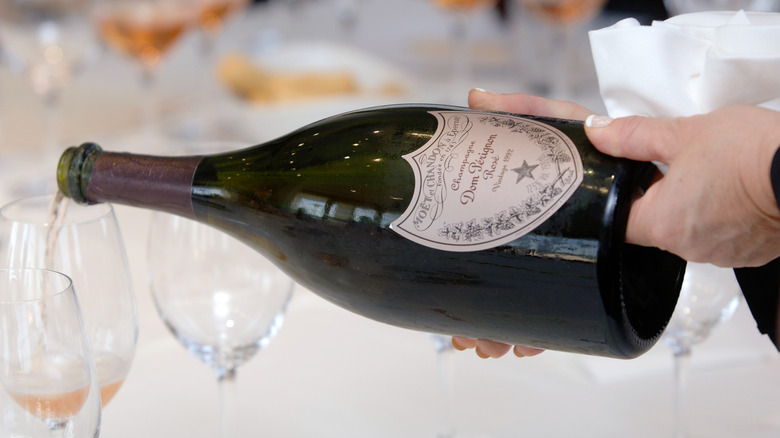Dom Pérignon Vintage Champagne: Everything You Need To Know
Whether you've sipped the elixir yourself or only recognize Dom Pérignon from countless hip-hop songs, its association with luxury is undeniable. The brand has some serious fans and people who are willing to put down thousands of dollars to get their hands on the rarer bottles, while even the most basic start at $185, per Luxe Digital. If you're wondering what sets it apart from the various Champagne houses producing tasty bubbles, Dom — as aficionados call it — is certainly made with opulence in mind.
Given that taste is highly subjective, if you don't have the budget for luxury Champagne and are happy to drink your usual suspects, then by all means continue to do so. However, if you're curious about exploring the distinct nature of Dom Pérignon and the characteristics that make it so highly sought after, then read along as we divulge everything there is to know about the Champagne. That way, when you've got an extra couple of hundred dollars to spare, you might taste the bubbly drink for yourself.
Dom Pérignon played a big role in Champagne's history
Any brand named after a real person — and a Benedictine monk at that — entails various tales regarding the fellow in question. Guild Somm asserts that Dom Pérignon is regularly miscredited as being responsible for inventing Champagne. While his winemaking efforts were valuable, the traditional method of sparkling wine (the only one permitted in Champagne) was developed by an English scientist, per BBC.
Instead, the monk was working to prevent the wasteful explosion of wine bottles undergoing secondary fermentation, according to Decanter. When there is still sugar in wine and the bottle is sealed, as Vinepair noted, the yeast continues to ferment and release alcohol and carbon dioxide, hence the explosions. If a strong bottle and proper cork are used, the process can smoothly occur, producing the delicious bubbles typical in a glass of Champagne. Guild Somm notes that the monk's accomplishments began in the vineyard. He prioritized pruning, and as far as harvesting was concerned, his process was meticulous, picking them on different days to guarantee ideal ripeness. By ensuring the condition of the grapes and removing any that weren't up to par, the quality of the wine improved.
More specifically to Champagne sparkling wine, the monk developed the practice of blending different grapes to perfect flavor. Additionally, Pérignon figured out that by reducing the time the grape skins touched the juice, he could make white wine from red grapes.
Dom Pérignon is owned by a luxury brand
Although the idea of a monk making individual bottles of Champagne is quaint, Dom Pérignon isn't a low-scale production. In fact, Decanter reports that the brand came under the ownership of Moët & Chandon in 1937, who named their prestige cuvée (top of the line) after the influential monk.
Eventually, Dom was bought by the Moët Hennessy Louis Vuitton (LVMH) luxury empire in 1987. The company oversees 75 other brands in various spheres including wine, fashion, leather goods, perfume, and jewelry. According to Insider, the Champagne house is one of LVMH's oldest companies. In an interview with CNBC, the company's billionaire owner Bernard Arnault declared he was certain that the Champagne label would endure in popularity for decades to come.
LVMH isn't only promoting Dom Pérignon Champagne; Veuve Clicquot, Krug, Ruinart, and Moët & Chandon are other bubbly brands under the overarching name. However, among the selection, Dom Pérignon exclusively bottles wine from years with the best conditions, setting the bar high for the rest.
Each bottle is of a single vintage
In keeping with the brand's exclusive nature, Dom Pérignon only produces vintage wines, meaning that grapes from the same year are used for each release. This allows the wine to showcase the seasonal characteristics that vary from year to year, ensuring a highly unique bottle. As James Beard Award winner sommelier Belinda Chang told Vinepair, "Vintage Champagnes are more complex and demand more thought."
In contrast, non-vintage Champagne is composed of a blend of grapes from various years, resulting in a homogeneous and recognizable product meant to depict a brand's flagship style, per Glass of Bubbly. Although vintage Champagne gets the most prestige, the outlet reports that it only accounts for around 5% of all production, hence its rarity.
According to Vinepair, vintage Champagne is usually only produced a few times per decade since the conditions are not always suitable to guarantee sufficient quality grapes to make wine. The decision as to whether or not a vintage of Dom Pérignon will be made is the yearly responsibility of the cellar master (via LVMH). While other industries might push to release a product as often as possible, the luxury Champagne has been produced less than 50 times in the last century, according to The Finest Bubble. Consequently, you can be certain that when you purchase one of these fine bottles, a number of factors have aligned to ensure its peak excellence.
It is made with two different grape varieties
The governing body that regulates the production of wine in the Champagne AOC (controlled designation of origin) has rules regarding all aspects of the viticultural and winemaking process, according to Comité Champagne. This ensures quality as well as a certain uniformity across the characteristics of all Champagne. The prestigious sparkling wine must be made using seven permitted grape varieties, most notably Chardonnay, Pinot Noir, and Pinot Meunier.
Each Champagne brand selects which grapes to use depending on the style of wine to be produced, as well as yearly conditions. Dom Pérignon is exclusively made with Chardonnay and Pinot Noir in approximately equal parts, per Decanter. Although the ratio may sometimes skew towards a higher proportion of one grape over the other, an overall balance is achieved. In an interview with Best Champagne, Richard Geoffrey, the brand's highly revered cellar master from 1990 to 2018, described how the two grapes create a harmonious yet contrasting blend: "This duality is represented by the Pinot Noir, more powerful and the Chardonnay, more elegant."
There are particular aging requirements
The Comité Champagne has regulations specifying the aging duration before bottles can be released for sale. The minimum time for non-vintage Champagne is 15 months while vintage bottles must rest for at least three years. During this time, the wine sits on the lees (dead yeast cells), enhancing the flavor and providing a creamier mouthfeel to the final product, according to Wine Folly.
Dom Pérignon takes it a step further by aging the wine for a minimum of seven years in the cellar. Allowing the wine to sit and slowly develop over time creates richer, more complex aromas that make it so unique. To fully highlight the progression of the Champagne over time, Dom is often released in stages, bottled as the Plénitude series.
In an interview with Best Champagne, Richard Geoffrey explained that the P1, P2, and P3 labels of a certain vintage consist of the same wine at different stages in its development, which he compares to a person's evolution throughout their lifetime. P1 is the standard release sold around eight or nine years following the vintage. P2 comes out 15 or 20 years later, while P3 rests for over 25 years before becoming available to the public.
Dom Pérignon has caught the eye of fraudsters
Given the premium price the average bottle garners, Dom Pérignon Champagne is a prime target for scammers. Numerous counterfeiters have falsely reproduced the prestigious wine, often successfully selling it far beyond its worth. Purchasing wine from reputable retailers who can ensure authenticity is one way to avoid splurging on a fake, per Vinfolio.
In 2021 Vino Joy News reported that two cases of the Luminous Millesime Brut Vintage 2002 sold for over $6,000. The bottle labels are colorful which was ultimately the demise of the counterfeiter. Only green and red labels were actually printed, leading the buyer (who was none other than the Moët Hennessy company) to realize that the case containing assorted colorful labels was a fake. Other inconsistencies and careless spelling mistakes led to court proceedings and ultimately a payout to Moët.
Meanwhile, some consumers actually got bottles of Dom disguised as ordinary house wine, while the Champagne house got ripped off in the process. According to The Independent, Turkish buyer Dogan Arslan fooled countless French vineyards — including those owned by Dom Pérignon — by paying for cases of wine with bounced checks. In the wine business, cases are typically shipped before payment is received. Instead of selling the prestigious wine for top dollar, Arslan sold it below its market price to Turkish restaurants in London. Since he wasn't actually paying for anything, he was able to rack up millions of dollars of profit.
It's one of the few to have a 2010 vintage
Since vintage Champagne is meant to display the best years, its production isn't always meant to be. The conditions throughout the 2010 growing season were not great, per Wine-Searcher. Forbes called it "one of the most challenging vintages ever," while Bloomberg described it as "a year winemaker's wish to forget." Suffice to say that most Champagne houses did not decide to produce a vintage wine to highlight the year.
Dom Pérignon on the other hand produced an admirable Champagne that received respect from the industry and consumers alike. According to Forbes, the harvest entailed tediously picking through mediocre grapes to find those that were suitable to make wine. Thankfully, of the two grapes used in the blend, Chardonnay had fully ripened though Pinot Noir wasn't at its best. The cellar master chose to produce a combination of 54% Chardonnay and 46% Pinot Noir, resulting in a fresh, bright, and fruity wine, per Nuvo Magazine. If you come across a bottle of this rare vintage and can afford to splurge, be sure to snag it.
It's popular among film and music celebrities
You can bet that the rich and famous love popping bottles of Dom. While the Champagne is often referenced in rap music, other noteworthy fans include Marilyn Monroe. Club Oenologique reports that the famous blonde was fond of the opulent bubbles. She was immortalized drinking them in "The Last Sitting" photoshoot shortly before her death in 1962. According to The New York Times, Martha Stewart is also a fan of the Champagne, and even hosted a vintage themed party in 2004, serving bottles of 1998 P2 Dom.
Few characters are as enduring as James Bond, and British wine writer Jancis Robinson carefully chronicled his love for Champagne. While his passion extended beyond Dom Pérignon, the brand featured in most of the first ten Bond films in the '60s and '70s. Robinson reports that in 1979 the Moët Hennessy company chose not to offer up free Dom for the film premieres, ending its appearance on the big screen.
Meanwhile, many rappers sing about the extravagant bubbles, such as Notorious B.I.G. in the song "Party and Bulls***." As well, Hyphy Hip Hop lists 50 Cent, A Tribe Called Quest, and Hodgy Beats with Domo Genesis among artists who've rapped about Dom Pérignon. The Boombox also noted that Nas mentioned the Champagne in "The World is Yours." Thanks to its appealing allure and recognition as a status symbol, Dom Pérignon is a regular in the entertainment world.
International royalty drinks Dom
It should come as no surprise that various international royals drink these prestigious bubbles. One of the most famous instances occurred at Lady Diana and Prince Charles' wedding. As recounted by Vinovest, Magnums of 1961 Dom Pérignon Vintage Champagne were served at the event, after patiently aging for two decades. Apart from the contents which we'll assume were delicious, the label was one of a kind, with a dedication in honor of the duo's marriage, according to Christie's.
In the early 2000s, leftover bottles made their way into auction houses, and while some managed to sell for several thousand dollars, per Bonhams, most bottles went for considerably less. In fact, the CBC reported that an auction house in London had to call off a bottle's sale when the bidding began to stagnate below the reserve price.
Meanwhile, in 1971 in a different part of the royal world, the Shah of Iran celebrated 2,500 years of the Persian Empire by popping open some bottles of 1959 Dom Pérignon Rosé, per Decanter. Of the 360 bottles produced, a number still circulate in the market, including two bottles that sold at an auction in 2008 for the sum of $84,700. That's enough to make you feel like royalty with each sip.
Stars have collaborated with the luxury brand
While you might be unable to visualize anyone besides a monk when you think of Dom Pérignon, the brand has included many familiar faces in its advertising campaigns. In 2021, Lady Gaga became the face of Dom Pérignon, in what the Champagne house called "A world where absolute creative freedom rules and runs free." According to Decanter, the bottles in question were a 2010 Vintage and a 2006 Vintage Rosé. To supplement the artistic collaboration, Lady Gaga designed a sculpture with fashion director Nicola Formichetti, encasing a jeroboam (three-liter bottle) of the 2005 Rosé Vintage.
She's not the only A-list musician who has gotten cozy with the brand; Lenny Kravitz posed as the Champagne house's creative director and photographer in their collaboration. His project dove into the inspiration that is born from the experience of savoring Champagne. Along with captivating photoshoots and commentary, Kravitz also produced a limited edition bottle featuring a hammered metal plate as the label.
Dom Pérignon can be a good investment
While drinking Champagne is worthwhile in and of itself, there are plenty of other ways to obtain value from your purchase. According to Wine Academy, purchasing cases of Dom Pérignon to hold in long-term storage could result in a big payout. As the outlet explains, the demand for this prestigious brand of bubbles is high and spans to international consumers.
While it's difficult (not to mention, extremely pricey) to purchase old vintages, opting for recent releases and reselling them in the future appears to be reliably profitable, per Vinovest. The fine wine investment company claims that Champagne is a recession-proof good, citing the minimal 0.6% drop in Dom Pérignon's stock during the 2008-2009 stock market crash as a prime example. Overall, the price of the wine tends to appreciate over time, with certain vintages and wine styles garnering particularly peak prices.
The glitzy bubbles are regulars at auctions, often selling for exorbitant prices. Of course, it still takes a fair bit of cash to start the investment, as value is typically only given to full cases, per Champagne Every Day. You'll also have to ensure its optimal storage or else its worth can easily be discounted. If you're curious to start investing in Dom Pérignon, then keep an eye out for unique releases receiving plenty of buzz and most importantly, be patient.
It sold for a world record price in 2020
Given Dom Pérignon's high prestige, it's no surprise that it's a favorite at auction houses and among collectors. Enthusiasts are regularly willing to push the boundaries of what most people would consider ever spending on wine — in an entire lifetime! Case in point, according to Vinovest, a collection of 30 rosé bottles from the Oenethèque series sold for around $170,000 in 2020.
It's not the first time the prized Champagne has sold for multiple figures. According to The Shout, in 2008, three Dom Pérignon Oenethèque Magnums from 1966, 1973, and 1976 sold for just over $97,000 at an auction. Not to mention, the two bottles of 1959 rosé served at the celebration of the Persian Empire which sold for around $85,000, per Decanter.
Meanwhile, special limited edition bottles regularly start in the five digits. Finances Online reports that a 1996 Methuselah (equal to eight standard bottles) of Dom Pérignon Rosé Gold retails for around $50,000. To add to the glitz, the bottle is plated in gold and only 35 were ever produced.
It's worth noting that Dom Pérignon Rosé typically reaches peak prices, as early as its initial release. Canadian wine writer Natalie Maclean explains that the process simply requires more labor and time to complete, making it more expensive from the onset. Rosé Champagne is one of the only instances in winemaking in which red and white wine are mixed to produce the pink beverage.
It is not a Grand Cru Champagne
Dom Pérignon is undeniably a well-made luxury Champagne, yet you might be surprised to know that it does not qualify as a Grand Cru Champagne. This designation is given to 17 villages in the Champagne vineyard region deemed to be of superior quality around 100 years ago (via Forbes). At the time, these villages were classified in order to provide a metric for the sale of grapes. Fruit grown in Grand Cru villages sold at the maximum price, and all other areas received a fraction of the cost.
Forbes reports that since 2004, this method of pricing grapes is no longer used, however, the title of Grand Cru (and Premier Cru which follows), remains associated with specific villages. Although it does not carry any additional meaning of value, the name still holds importance and prestige for some people.
Nonetheless, excellent bubbles are being produced around the Champagne region without affiliation to a particular tier. Notably, Dom Pérignon Champagne does not make the cut into Grand Cru territory. While the wine is made using fruit from eight Grand Cru villages, it also includes grapes from a Premier Cru area named Hautvillers, Ficofi explains. That fact should be sufficient to demonstrate that labels don't always equal quality.
Serving it the right way enhances its features
While Champagne flutes are the most obvious way to present any type of bubbles, many wine experts eschew the narrow glasses. Matt Knight, business manager at the glassware company Riedel, told Insider that unfortunately neither flutes or coupes (another traditional glass for serving Champagne) have the appropriate characteristics to highlight the beverage.
Flutes have the benefit of keeping sparkling wine bubbly, however, by the same token, they also prevent the wine's aromas from diffusing to your nose. It's common to drink Champagne to celebrate and clink glasses, but if you're splurging on Dom Pérignon it's worthwhile to take a moment to appreciate its qualities. Knight explained to Insider that Riedel developed a tulip glass that is wider around the middle and narrower at the top. This preserves the bubbles while giving the aromas space to spread out. Meanwhile, Dom's revered cellar master Richard Geoffrey serves it in a standard crystal wine glass instead of a specific Champagne glass, per The Real Review. You don't have to purchase new glassware; a white wine glass is regularly recommended by sommeliers at Champagne houses, per Letting the Wine Speak.
While you might be used to drinking ice cold bubbles, this luxurious wine should be served at a temperature of 50 to 55 F to highlight the aromas, per The Real Review. If you're tasting a unique vintage of Dom Pérignon, do yourself a favor and keep the food simple in order to experience it fully.
